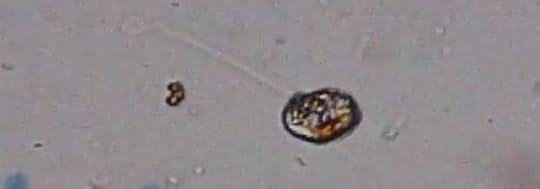By Teaching, We Learn

A single-celled organism from genus Anisonema, as captured by high school student Brynna Taylor.
I have a small plaque on my wall that reads, “Docendo Discimus.” It is a Latin proverb that means, “By teaching, we learn.” The very first time I helped a friend with her homework, I realized the truth of that proverb, and it is one of the reasons I enjoy teaching so much. I love to learn, and since teaching helps me to learn, I love to teach. Part of the proverb’s truth comes from the fact that as we explain things to others, we think about them in new ways, which often leads to new insights. Over the years, however, I have found other ways that teaching helps us to learn, and I experienced one of them this past weekend.
Because of the Lord’s leading, I decided to offer some online high-school courses this year. It has been a blast teaching students from all over the U.S. as well as a handful of foreign countries. Along with the joy of teaching and getting to know students, however, comes the drudgery of grading. While I love the former, I most certainly do not love the latter. However, on Saturday, I graded lab reports from my various classes.
I started with my high school biology class, which had spent the last week or so culturing pond water and looking at samples of it under the microscope. A lab like that is “hit or miss,” because finding interesting microscopic creatures in pond water depends on a lot of factors. Some students see many organisms, while other students see few or none at all. I was in the “monotony zone,” having gone through several lab reports, when I came across a submission with an excited note attached. The student, Brynna Taylor, was thrilled with what she saw, and she just had to share a few videos with me.
The first of three videos is posted (with her permission) below. She thought the organism she was focusing on was a Euglena, and while I understood her reasoning, I quickly realized she wasn’t correct. Euglena typically have only one flagellum (a tail-like appendage used to move around), and the organism she was focusing on had two. In addition, only one seemed to be used for movement. The other was pushed out in front of the organism, almost like it was using the flagellum to sense what was ahead.
I had never seen anything like that before, so I did some research and came up empty. Then I did something I rarely do. I asked my sister-in-law (who is a biology professor) for help. She has forgotten more biology than I will ever know, and I always learn more about the subject when I visit her and her husband, who is a world-renowned expert in molecular biology. However, they are both very busy people, so I don’t like to bother them unless I have no other options. I sent her the video, and she also couldn’t identify the organism. However, she gave me some ideas on how to refine my search, and I eventually learned that this interesting organism is from genus Anisonema in kingdom Protista, subkingdom Protozoa.
I have probably searched hundreds of drops of pond water under the microscope throughout my life, and I have seen a lot of “cavorting beasties,” as Anton van Leeuwenhoek referred to them when he first saw them in 1673. I thought I had pretty much seen it all, but I didn’t even know about this genus. However, because a student was excited about what she saw, I learned about a genus that was entirely new to me. My sister-in-law did as well. When I asked her to confirm my identification, she said:
That does look like the video. Good work! Protists are so hard — so darn many of them!!
While learning about a genus that is entirely new to me is interesting, I learned something even more valuable from Miss Taylor: God’s creation is so marvelously complex and diverse that there is no way you could see everything there is to see, even when you are just looking at a drop of pond water!
If you would like to see the other videos Brynna Taylor shared with me, they are given below. This one is (most likely) a Euglena:
This last one really demonstrates why Anton van Leeuwenhoek referred to microscopic organisms as “cavorting beasties.” Unlike the previous two videos (which came from a freshwater pond), this comes from a sample of ocean water. Miss Taylor had put an egg in the ocean water to give the microorganisms something to eat, and a slime developed. She put a sample of slime under the microscope, and the video below is the result. There are a lot of different microorganisms there, but the most common ones seem to be paramecia.
Jay L. Wile's Blog
- Jay L. Wile's profile
- 31 followers



